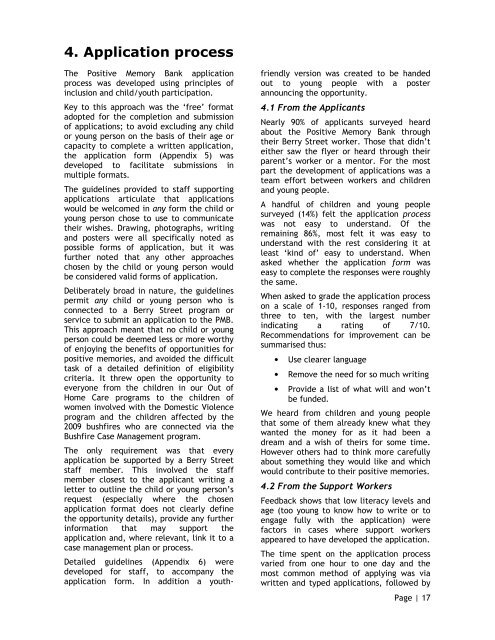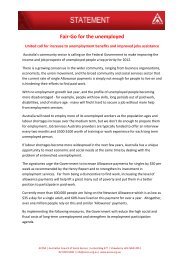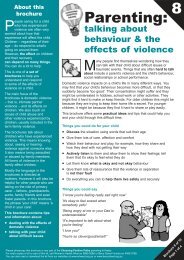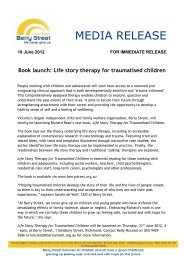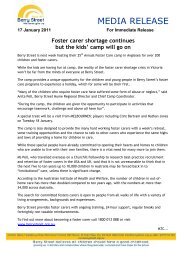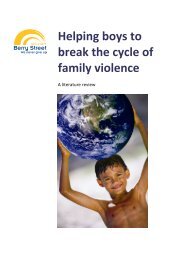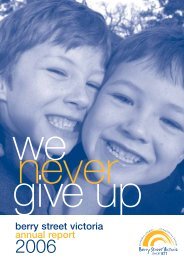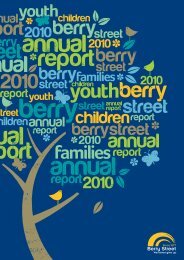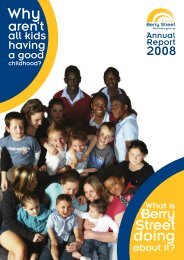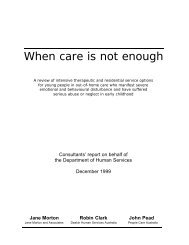Positive Memory Bank - Berry Street
Positive Memory Bank - Berry Street
Positive Memory Bank - Berry Street
Create successful ePaper yourself
Turn your PDF publications into a flip-book with our unique Google optimized e-Paper software.
4. Application process<br />
The <strong>Positive</strong> <strong>Memory</strong> <strong>Bank</strong> application<br />
process was developed using principles of<br />
inclusion and child/youth participation.<br />
Key to this approach was the ‘free’ format<br />
adopted for the completion and submission<br />
of applications; to avoid excluding any child<br />
or young person on the basis of their age or<br />
capacity to complete a written application,<br />
the application form (Appendix 5) was<br />
developed to facilitate submissions in<br />
multiple formats.<br />
The guidelines provided to staff supporting<br />
applications articulate that applications<br />
would be welcomed in any form the child or<br />
young person chose to use to communicate<br />
their wishes. Drawing, photographs, writing<br />
and posters were all specifically noted as<br />
possible forms of application, but it was<br />
further noted that any other approaches<br />
chosen by the child or young person would<br />
be considered valid forms of application.<br />
Deliberately broad in nature, the guidelines<br />
permit any child or young person who is<br />
connected to a <strong>Berry</strong> <strong>Street</strong> program or<br />
service to submit an application to the PMB.<br />
This approach meant that no child or young<br />
person could be deemed less or more worthy<br />
of enjoying the benefits of opportunities for<br />
positive memories, and avoided the difficult<br />
task of a detailed definition of eligibility<br />
criteria. It threw open the opportunity to<br />
everyone from the children in our Out of<br />
Home Care programs to the children of<br />
women involved with the Domestic Violence<br />
program and the children affected by the<br />
2009 bushfires who are connected via the<br />
Bushfire Case Management program.<br />
The only requirement was that every<br />
application be supported by a <strong>Berry</strong> <strong>Street</strong><br />
staff member. This involved the staff<br />
member closest to the applicant writing a<br />
letter to outline the child or young person’s<br />
request (especially where the chosen<br />
application format does not clearly define<br />
the opportunity details), provide any further<br />
information that may support the<br />
application and, where relevant, link it to a<br />
case management plan or process.<br />
Detailed guidelines (Appendix 6) were<br />
developed for staff, to accompany the<br />
application form. In addition a youthfriendly<br />
version was created to be handed<br />
out to young people with a poster<br />
announcing the opportunity.<br />
4.1 From the Applicants<br />
Nearly 90% of applicants surveyed heard<br />
about the <strong>Positive</strong> <strong>Memory</strong> <strong>Bank</strong> through<br />
their <strong>Berry</strong> <strong>Street</strong> worker. Those that didn’t<br />
either saw the flyer or heard through their<br />
parent’s worker or a mentor. For the most<br />
part the development of applications was a<br />
team effort between workers and children<br />
and young people.<br />
A handful of children and young people<br />
surveyed (14%) felt the application process<br />
was not easy to understand. Of the<br />
remaining 86%, most felt it was easy to<br />
understand with the rest considering it at<br />
least ‘kind of’ easy to understand. When<br />
asked whether the application form was<br />
easy to complete the responses were roughly<br />
the same.<br />
When asked to grade the application process<br />
on a scale of 1-10, responses ranged from<br />
three to ten, with the largest number<br />
indicating a rating of 7/10.<br />
Recommendations for improvement can be<br />
summarised thus:<br />
• Use clearer language<br />
• Remove the need for so much writing<br />
• Provide a list of what will and won’t<br />
be funded.<br />
We heard from children and young people<br />
that some of them already knew what they<br />
wanted the money for as it had been a<br />
dream and a wish of theirs for some time.<br />
However others had to think more carefully<br />
about something they would like and which<br />
would contribute to their positive memories.<br />
4.2 From the Support Workers<br />
Feedback shows that low literacy levels and<br />
age (too young to know how to write or to<br />
engage fully with the application) were<br />
factors in cases where support workers<br />
appeared to have developed the application.<br />
The time spent on the application process<br />
varied from one hour to one day and the<br />
most common method of applying was via<br />
written and typed applications, followed by<br />
Page | 17


